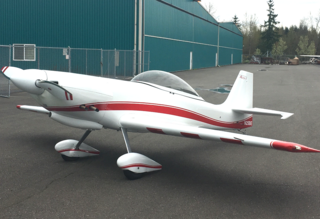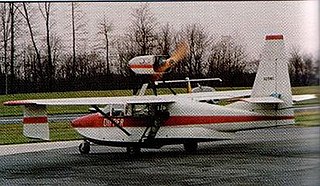Related Research Articles

The Bradley BA 100 Aerobat is an American aerobatic homebuilt aircraft that was designed and produced by Bradley Aerospace of Chico, California. When it was available the aircraft was supplied as a kit for amateur construction.

The Norman Aviation Nordic VII is a Canadian advanced ultralight aircraft, that was designed by Jacques Norman and produced by Norman Aviation of Saint-Anselme, Quebec. The aircraft was supplied as a kit for amateur construction or as a complete ready-to-fly-aircraft.

The St-Just Cyclone, also called the St-Just Cyclone 180, is a Canadian homebuilt aircraft that was designed and produced by St-Just Aviation of Mirabel, Quebec. The company has since moved to Boucherville, Quebec. While it was available the aircraft was supplied as a kit and in the form of plans for amateur construction.
The Rayner Pusher is a homebuilt version of the Curtiss Pusher.

The Rihn DR-107 One Design is an American aerobatic homebuilt aircraft that was designed by Dan Rihn and first flown in 1993. The aircraft is supplied by Aircraft Spruce & Specialty of Corona, California in the form of plans and a materials kit for amateur construction.
The Rihn DR-109 is an American aerobatic homebuilt aircraft that was designed by Dan Rihn. The aircraft was supplied by Jim Kimball Enterprises of Zellwood, Florida and more recently by Ashcraft Aero Works of Aurora, Illinois in the form of plans. It was designed for competition aerobatics as well as a trainer for the Rihn DR-107 One Design.

The Aircraft Technologies Acro 1 is an American aerobatic homebuilt aircraft that was designed by Fred Meyer and produced by Aircraft Technologies of Lilburn, Georgia. When it was available the aircraft was supplied as a kit or in the form of plans for amateur construction. Neither plans nor kits are available anymore and the aircraft is out of production.
The Bagalini Bagalini is an Italian homebuilt ultralight aircraft that was designed by Marino Bagalini. The aircraft is supplied in the form of plans for amateur construction.

The Collins Dipper was an American homebuilt flying boat that was designed and produced by Collins Aero of Chadds Ford, Pennsylvania and first flown in 1982. The aircraft was supplied in the form of plans for amateur construction. Only one was built and none remain registered.

The Culp Special is an American aerobatic homebuilt aircraft designed and produced by Culp's Specialties of Shreveport, Louisiana. The aircraft is supplied as a kit or in the form of plans for amateur construction.
The Junkers Profly Ultima is a German aerobatic homebuilt aircraft that was designed by Andre Konig and produced by Junkers Profly of Kodnitz, introduced in 1993. When it was available the aircraft was supplied as a kit for amateur construction.
The Progressive Aerodyne Stingray is an American homebuilt flying boat that was designed by and produced by Progressive Aerodyne of Orlando, Florida, introduced in the 1990s. When it was available the aircraft was supplied as a kit for amateur construction.
The Redfern DH-2 is an American homebuilt aircraft that was designed by Walter Redfern and produced by the Walter Redfern Company of Post Falls, Idaho, based upon the 1915 Airco DH.2 fighter aircraft. When it was available the aircraft was supplied in the form of plans for amateur construction.

The SkyDancer SD-260 was an American aerobatic homebuilt biplane that was designed and produced by SkyDancer Aviation of Louisville, Kentucky, introduced in the mid-1990s. When it was available the aircraft was supplied as a kit.

The Starfire Firebolt, sometimes called the Starfire Firebolt Convertible, due to its removable canopy, is an American homebuilt aerobatic biplane that was designed by G. H. "Mac" McKenzie and produced by Starfire Aviation of Tempe, Arizona. When it was available the aircraft was supplied in the form of plans for amateur construction, with some pre-fabricated parts available.

The Stolp SA-900 V-Star is an American aerobatic homebuilt biplane, currently produced by Aircraft Spruce & Specialty Co in the form of plans for amateur construction. In the 1990s it was also available as a kit from Stolp Starduster Corporation of Riverside, California.
The Tech Aero TR 200 is a French homebuilt aerobatic aircraft that was designed and produced by Tech Aero of Glisolles, first flown in August 1988. When it was available the aircraft was supplied as a kit for amateur construction.
The VSR SR-1 Snoshoo is an American homebuilt Formula One racing aircraft that was designed by Alan VanMeter and A.J. Smith and produced by VanMeter Smith Racing (VSR) of Wichita, Kansas. It was designed in 1993 and first flown in 1997. The aircraft is supplied in the form of plans for amateur construction, with some key parts available to speed construction.
The Washington T-411 Wolverine is an American homebuilt aircraft that was produced by Washington Aeroprogress of Seattle, Washington, introduced in the 1990s. When it was available the aircraft was supplied as a kit or in the form of plans for amateur construction.
The Bradley BA-200 ATAC was an American homebuilt aircraft that was designed by Bradley Aerospace of Chico, California, introduced in the mid-1990s. The aircraft was intended to be supplied as a kit for amateur construction, but is likely that only one was constructed.
References
- 1 2 3 4 5 6 7 8 Purdy, Don: AeroCrafter - Homebuilt Aircraft Sourcebook, Fifth Edition, page 361. BAI Communications, 15 July 1998. ISBN 0-9636409-4-1
- 1 2 Freeze, Di (November 2005). "The Path to the Viperjet MkII – The Trickest Jet on the Block". Pacific Northwest Aviation & Business Journal (Airport Journals) 4 (10): 8C–14C.
- ↑ Federal Aviation Administration (May 9, 2015). "Make / Model Inquiry Results" . Retrieved May 9, 2015.